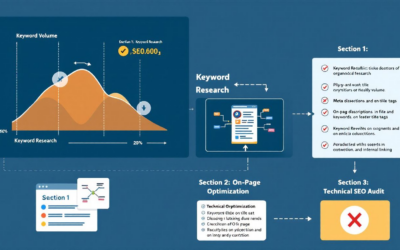Is your domain name no longer under your control? Don’t worry. There are a few options available for reclaiming a lost domain name. This guide will walk you through the steps on how to get back my domain name. From identifying the current owner to contacting your registrar and understanding expiration periods, we’ll provide actionable steps for a successful recovery.
Key Takeaways
-
Identify the current domain owner using WHOIS to understand your next steps.
-
Act quickly by contacting your registrar and documenting any incidents of domain loss.
-
Implement security measures like auto-renewal and two-factor authentication to prevent future losses.
Identify the Current Domain Owner

To begin the process of retrieving your lost domain names, it is essential to determine who currently has control of them and establish the identity of the rightful owner. This may seem like a simple task, but it’s a fundamental step in understanding how to proceed.
Employing the WHOIS database will allow you to discover details about the current registrant such as their name, address, and contact information. Just insert your lost domain name into a WHOIS search facility to access this vital information.
In instances where this data is kept private by the registrant, Investigation or reaching out directly to their domain registrar could assist in revealing these crucial contact details regarding ownership.
It is also important to use a domain privacy provider to protect one’s mailing address from being publicly disclosed in WHOIS directories.
Contact Your Domain Registrar Immediately
Upon determining who presently owns the domain, reach out to your domain registrar without delay and inform them of the situation. Swift action enhances the likelihood of a successful restoration.
The registrar will be instrumental in assisting you through the steps needed to recover control. Should you find yourself unable to enter into the connected email account, ask for an alteration of the main contact email so that access to your account managing your domain can be reestablished.
When dealing with incidents involving theft of a domain, make it a point to record all details by reporting it to local law enforcement agencies as this provides essential legal support for any recovery endeavors. The key elements are rapid response and meticulous recording throughout these circumstances.
Understand Domain Expiration and Redemption Periods
It is essential to grasp the significance of a domain’s expiration date and its associated redemption period for successful retrieval. After the completion of a typical one-year registration term, domains reach their expiry point, subsequently transitioning into a grace period where reactivation by the initial owner can occur without extra charges. Failing to renew a domain can lead to it being purchased by someone else, making it difficult to reclaim once the new owner renews it.
In instances where renewal has not been executed within this grace period, the domain advances into what is known as a redemption phase that spans about 30 days. During this interval, restoration remains attainable albeit often subject to additional fees with specific stipulations differing according to each registrar.
Should restitution fail to materialize throughout this redemption timeframe, there exists the potential for said domain to be made accessible once again through general registration—thus available anew for public claim. Employing an auto-renewal feature can aid in circumventing accidental expirations and protect against unintentional forfeiture of ownership.
Secure Legal Assistance if Necessary
Should you fall victim to unauthorized transfers of your domain, enlisting the help of legal professionals could be the most advisable step. Attorneys specializing in domain disputes are equipped with strategies for reclaiming domains and can offer crucial guidance.
In instances where another party has taken ownership of your domain, initiating dialogue via WHOIS information might facilitate negotiation. Should such discussions not yield results, lodging a UDRP complaint is an avenue to pursue recovery of a domain registered under trademark infringement.
Engaging legal support frequently presents the optimal opportunity to reestablish control over your domain and accelerate its return process.
Recovering an Expired Domain
Taking swift measures is vital when dealing with an expired domain. The promptness of your response greatly enhances the likelihood of regaining the domain without incurring excessive expenses. Initiate this process by utilizing a WHOIS lookup service to ascertain if the domain remains unclaimed.
Should you find that the domain is yet to be taken, reach out to your registrar and settle any outstanding charges required for its retrieval. At times, it may entail entering into negotiations with its present holder. To successfully reclaim ownership of an expired domain, being expeditious and tenacious is essential.
Implementing Domain Security Measures

Securing your domain against future losses is equally critical to the process of retrieving a lost one. By enabling auto-renewal for your domain registration, you can avoid lapses in ownership and circumvent unnecessary complications.
Enhancing the security settings on your account with two-factor authentication adds an additional defense level, safeguarding against unsolicited access. It’s also vital to maintain current contact details on file with your registrar so that you receive essential alerts regarding your domain.
Opting for a well-regarded registrar when registering or managing your domain helps protect it from unauthorized use and inadvertent loss. Privacy options offered by registrars obscure personal information within public WHOIS databases, thereby decreasing the risks associated with identity theft.
Registering a New Domain as a Last Resort
Should you find yourself at an impasse, securing a new domain may emerge as the optimal strategy. It’s advisable to look into obtaining a comparable domain or selecting another extension that aligns with your brand for seamless continuity. Swift decision-making is essential because domain names are typically allocated to those who stake their claim earliest.
Alternatively, one of the possible courses of action could be contacting the current owner regarding acquisition prospects. Although this route might not always be practical, it deserves consideration when your preferred original domain is no longer accessible.
Protecting Your Domain Going Forward

To prevent the risk of losing your domain, it is critical to put strong security protocols in place. Opt for automatic renewal settings and distribute access privileges across a number of reliable personnel while ensuring consistent upkeep of domain cleanliness.
Consistently refreshing your contact details and keeping vigilant oversight over your domain activities can help you avoid potential problems down the line.
Summary
To recuperate a domain that has been lost, you should first determine who now owns it. Then reach out to your domain registrar for assistance. It’s important to grasp the nuances of expiration and redemption periods for domains. In cases where reclaiming your expired domain proves challenging, don’t hesitate to enlist legal support. Act swiftly to recover any lapsed domains, make sure robust security practices are in place going forward, and if all else fails, secure a fresh new domain as soon as possible. Encourage individuals to proactively safeguard their online territories with these measures in mind.
Frequently Asked Questions
How do I find out who owns my domain?
To ascertain the ownership of your domain, consult the WHOIS database.
This resource will supply you with all necessary information!
What should I do if my domain has expired?
Should your domain reach its expiration, promptly consult WHOIS to ascertain if it’s still available. Immediately contact your registrar to inquire about the possibility of renewal.
It is crucial not to delay this process as there is a risk you could permanently lose the domain!
How can I prevent my domain from expiring?
To prevent your domain from lapsing, simply enable the auto-renewal feature through your registrar.
This is a straightforward method to guarantee that your website remains active continuously without any breaks!
What legal actions can I take if my domain is stolen?
Should your domain be unlawfully taken, it’s wise to lodge a UDRP complaint and seek the advice of a lawyer specializing in domain disputes for direction.
Can I register a new domain if I can’t recover my old one?
Certainly, it is possible to acquire a new domain if reclaiming your previous one proves unfeasible.
Consider selecting an alternate name or opt for a variant extension!









